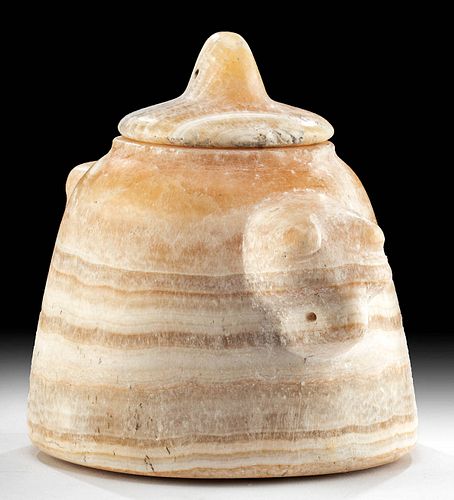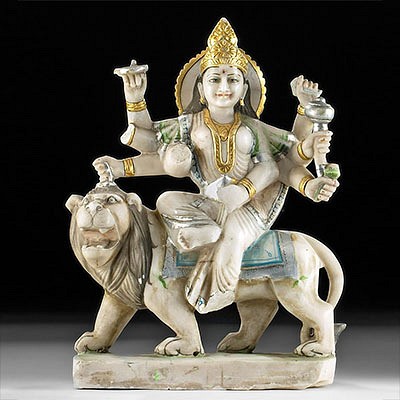South Arabian Qatabanian Alabaster Beehive Jar w/ Lid
Lot 59c
About Seller
Artemis Fine Arts
686 S Taylor Ave, Ste 106
Louisville, CO 80027
United States
Selling antiquities, ancient and ethnographic art online since 1993, Artemis Gallery specializes in Classical Antiquities (Egyptian, Greek, Roman, Near Eastern), Asian, Pre-Columbian, African / Tribal / Oceanographic art. Our extensive inventory includes pottery, stone, metal, wood, glass and textil...Read more
Categories
Estimate:
$2,500 - $3,500
Absentee vs Live bid
Two ways to bid:
- Leave a max absentee bid and the platform will bid on your behalf up to your maximum bid during the live auction.
- Bid live during the auction and your bids will be submitted real-time to the auctioneer.
Bid Increments
| Price | Bid Increment |
|---|---|
| $0 | $25 |
| $300 | $50 |
| $1,000 | $100 |
| $2,000 | $250 |
| $5,000 | $500 |
| $10,000 | $1,000 |
| $20,000 | $2,500 |
| $50,000 | $5,000 |
| $100,000 | $10,000 |
| $200,000 | $20,000 |
About Auction
By Artemis Fine Arts
Jul 16, 2020
Set Reminder
2020-07-16 10:00:00
2020-07-16 10:00:00
America/New_York
Bidsquare
Bidsquare : Ancient / Ethnographic Art Through The Ages
https://www.bidsquare.com/auctions/artemis-gallery/ancient-ethnographic-art-through-the-ages-5334
Ancient art from Egypt, Greece, Italy and the Near East, as well as Asian, Fossils, Pre-Columbian, Native American, African / Tribal / Oceanic, Spanish Colonial, Russian Icons, Fine art, much more! Artemis Fine Arts info@artemisgallery.com
Ancient art from Egypt, Greece, Italy and the Near East, as well as Asian, Fossils, Pre-Columbian, Native American, African / Tribal / Oceanic, Spanish Colonial, Russian Icons, Fine art, much more! Artemis Fine Arts info@artemisgallery.com
- Lot Description
Ancient Middle East, South Arabia, Qatabanian culture, ca. 3rd century BCE to 1st century CE. A beautiful example of a squat jar with an accompanying lid that are both hand-carved from honey-yellow alabaster with integral cream-hued bands that illuminate when placed next to a light source. The jar body is defined by a slightly rounded but stable base, a tapered, bell-shaped body, a sloped shoulder encircling the raised rim, and a drilled-out interior cavity. Protruding from the shoulder are two abstract zoomorphic heads, perhaps bull heads, that double as handles with pierced string holes through the septum of each snout. The discoid lid has a protruding lower ring that fits within the rim as well as a pierced conical handle. Size (w/ lid): 5.625" W x 5.1" H (14.3 cm x 13 cm)
Beehive vessels like this one have been found at several sites throughout Arabia, with most coming from Yemen, although similar examples have been found as far afield as Bahrain. These vessels were made to hold oily unguents, frankincense, and myrrh. As a result, they are often found along trade routes like the Nabataean route in the Negev.
A stylistically similar example, with a lid surmounted by an abstract animal, hammered for $12,500 at Sotheby's, New York "Antiquities" auction (December 5, 2007, lot 35).
Provenance: private East Coast, USA collection; ex-Dr. Sid Port collection, California, USA, acquired in the 1980s
All items legal to buy/sell under U.S. Statute covering cultural patrimony Code 2600, CHAPTER 14, and are guaranteed to be as described or your money back.
A Certificate of Authenticity will accompany all winning bids.
We ship worldwide and handle all shipping in-house for your convenience.
#152950Losses to areas of shoulder and rim as shown. Lid is perhaps not original to the vessel body. Minor abrasions to base, body, zoomorphic handles, rim, and lid, with light encrustations within body, and softening to some zoomorphic details. Nice earthen deposits and smooth patina throughout.Condition
- Shipping Info
-
All shipping is handled in-house for your convenience. Your invoice from Artemis Gallery will include shipping calculation instructions. If in doubt, please inquire BEFORE bidding for estimated shipping costs for individual items.
-
- Buyer's Premium



 EUR
EUR CAD
CAD AUD
AUD GBP
GBP MXN
MXN HKD
HKD CNY
CNY MYR
MYR SEK
SEK SGD
SGD CHF
CHF THB
THB
















